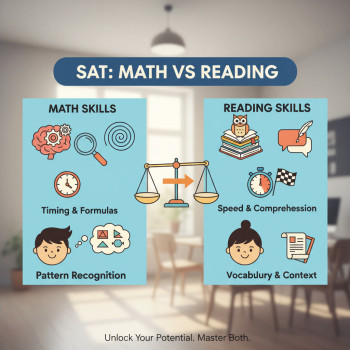Why Plan from Grade 10 to Grade 12?
Think of grades 10 12 as your academic runway. These three years are when you build momentum: you shape the transcript colleges see, you collect test scores that open doors, and you learn how to manage college-level coursework and exam prep without burning out. A thoughtful plan helps you choose AP classes that match your interests and strengths, time your Digital SAT testing sensibly, and layer in the kind of targeted practice that actually moves the needle.

Big Picture: How AP and the Digital SAT Fit Together
AP courses demonstrate that a student has taken rigorous, college-level classes. AP exam scores can earn college credit or advanced placement, and they also signal academic ambition to admissions officers. The Digital SAT evaluates core skills reading, writing, and math in a standardized format used by most U.S. colleges for admissions and placement conversations.
Both matter, but they serve different purposes. AP is coursework-plus-exam: long-term evidence of subject mastery. The Digital SAT is a point-in-time metric of college readiness skills. Planning both in tandem rather than treating them as competing priorities gives you the best chance to shine on applications and enter college with options.
Key differences at a glance
- AP shows sustained academic work in specific subjects across a semester or year; the Digital SAT is a timed standardized exam that tests general reasoning and content skills.
- AP scores are 1 5; many colleges grant credit or placement for scores of 3 or higher (policies vary by college).
- Digital SAT results are used by colleges for admissions and sometimes placement; colleges interpret them alongside GPA, coursework, and other application elements.
- AP courses can boost weighted GPA and demonstrate depth in a subject; SAT results are comparable across all applicants and help contextualize your academic performance.
Three-Year Roadmap Overview (G10 G12)
Below is a high-level timeline. After that, we ll unpack each year with concrete steps, study strategies, and examples so you can customize the plan for your goals.
| Grade | Main Focus | Milestones |
|---|---|---|
| Grade 10 | Explore AP options, build academic habits, early PSAT practice | Choose first AP(s), take PSAT practice, start light SAT prep |
| Grade 11 | Peak AP load (1 3 APs), official Digital SAT testing, targeted prep | Take Digital SAT, take AP exams in May, refine college list |
| Grade 12 | Selective APs, score sends, final SAT retake if needed, application focus | Send score reports, take final APs, finalize applications |
Grade 10: Planting Seeds Explore, Try, and Build Habits
Grade 10 is the exploration year. You re old enough to handle true AP work in some subjects, but it s also the best time to try one or two APs without overcommitting. The goal: discover strengths and develop study habits that scale.
Course selection strategies
- Start with 0 2 APs: choose subjects where you already have a strong foundation (for example, English Language if you enjoy writing, or Biology if you did well in Honors Biology).
- Talk to your counselor and AP teachers. Ask about workload, assessments, and whether the course is teacher-led or self-paced.
- Use AP course recommendations tied to PSAT/SAT practice scores to inform choices, but favor personal interest passion sustains performance.
Digital SAT: early familiarization
You don t need to sit the official Digital SAT in Grade 10, but you should be familiar with the test s format and timing. Try a practice test under timed conditions to learn pacing and to find which areas need development reading comprehension, evidence analysis, and specific math domains.
Study habits that matter
- Create a weekly schedule that balances homework, AP study time, and SAT practice. Consistency beats marathons.
- Practice active reading and short daily math drills to build fluency.
- Learn to use AP resources (classroom materials, AP Daily videos) and SAT digital practice tools.
If a student needs extra structure, Sparkl s personalized tutoring can be introduced here: 1-on-1 guidance helps set a tailored study plan, gives early diagnostic testing, and builds the habits that prevent panic later.
Grade 11: The Heavy Lifter Peak Testing and Coursework
Grade 11 is often the most critical year. Colleges will see your junior-year transcript as the strongest indicator of academic responsibility. This is also the year many students take official SAT administrations and the bulk of AP exams.
Decide your AP load
Common junior-year APs include AP English Literature, AP United States History, AP Calculus AB/BC, and science APs like AP Chemistry or AP Biology. Choose 2 4 APs depending on your resilience and extracurricular commitments. Quality matters more than quantity.
Digital SAT strategy
- Take at least one official Digital SAT in the spring or summer of Grade 11. This gives you an admissions-ready score and room for a retake in Grade 12 if desired.
- Use targetted practice on weaker areas revealed by your test report. For many students, focused work on data-interpretation questions or command-of-evidence tasks yields quick gains.
- Practice the adaptive nature of the digital test (if available in practice) and learn keyboard-based navigation, because comfort reduces test-day errors.
Balancing AP exams and SAT testing
AP exams are in May and typically overlap with AP coursework final pushes. Plan your SAT test dates to avoid cramming the same month as multiple AP exams. If possible, aim for an SAT administration in late spring or early summer (after spring semester exams) so you can focus on AP prep in April and early May.
How to structure weekly prep in Grade 11
- Weekly: Two to three 45 60 minute SAT practice sessions (targeted, not marathon). Alternate Reading/Writing and Math focus.
- Bi-weekly: Practice full-length Digital SAT under timed conditions to build stamina and pacing.
- AP coursework: Daily review of class notes and scheduled practice for FRQs and multiple-choice sections; use AP Classroom resources and past free-response questions for targeted practice.
For students juggling a heavy load, Sparkl s expert tutors can devise customized pacing: targeted SAT skill-building sessions, timed Digital SAT simulations, and AP-specific coaching that prioritizes the most score-impacting techniques (like FRQ structure or evidence-based argumentation). That one-on-one support helps maintain balance and prevent overload.
Grade 12: Fine-Tuning Targeted Retakes and Application Focus
Grade 12 is when you sharpen, not overhaul. Most of your academic identity is set; now it s about polishing test scores if needed, making strategic AP choices, and turning attention to applications.
APs in senior year choose selectively
Seniors often take APs that align with intended majors or where they can reasonably earn high scores with moderate workload: for example, AP Microeconomics, AP Psychology, or AP Computer Science Principles. Avoid adding a massive new AP if it could hurt your senior-year GPA or application focus.
Final SAT retake: when to do it
- If your Grade 11 SAT score met your target or your colleges are test-optional and you re happy, you may skip a retake.
- If you re a point or two away from a scholarship cutoff or a specific program requirement, plan a single focused retake in early fall of Grade 12 so scores arrive in time for application deadlines.
- Use a concise study plan: 4 6 weeks of deliberate practice post-diagnostic focusing on the weakest areas, plus two full practice tests.
Sending scores and AP score decisions
Understand score-send policies: decide whether to send AP scores early (you often get one free send per year) and whether to include your SAT score in early applications. Keep colleges credit and placement policies in mind when deciding which AP scores to send. Your counselor or a tutor can help prioritize which scores matter most for your college list.
Practical Study Plans and Weekly Routines
Here are two sample weekly routines one for a student with a moderate workload and one for a student carrying a heavy AP load.
| Student Type | Weekly SAT Practice | AP Study | Other |
|---|---|---|---|
| Moderate Load (1 2 APs) | 3 sessions x 60 minutes (mix of practice questions and review) | 4 6 hours (spread across subjects; include FRQ practice) | 1 full-length practice Digital SAT every 2 weeks; one college application task |
| Heavy Load (3+ APs) | 2 sessions x 45 minutes (targeted weak-skill drills) | 8 12 hours (short daily review + focused weekend blocks) | 1 full-length practice Digital SAT per month; weekly check-ins with tutor/counselor |
How to use practice tests effectively
- Simulate testing conditions. Digital format practice matters: practice on a screen, with the same time breaks.
- Review every practice test. Mark patterns: repeated errors on data analysis, weak evidence selection, or algebraic manipulation.
- Turn mistakes into a short remedial plan. If you miss a particular question type, do 10 similar questions until accuracy improves.
Common Pitfalls and How to Avoid Them
- Overloading on APs to impress colleges. Depth and strong grades trump a long list of low-graded APs.
- Neglecting test format practice. For the Digital SAT, screen-based practice and passage navigation skills are essential.
- Last-minute SAT cramming. Small, consistent practice beats intense short-term study.
- Ignoring AP FRQs. Practicing free-response formats early significantly improves AP outcomes.
Real-World Examples and Mini Case Studies
Here are three brief scenarios to show how the three-year plan can look in practice.
Case 1: The STEM-Intended Student
Grade 10: AP Biology or AP Physics 1, solid algebra II and honors chemistry. Begin digital SAT practice focusing on math fluency.
Grade 11: AP Calculus AB/BC, AP Physics C or AP Chemistry, take Digital SAT in spring. Heavy focus on timed math sections and data interpretation.
Grade 12: AP Computer Science or AP Statistics, retake SAT if needed. Use targeted tutoring for problem-solving shortcuts and AP FRQs.
Case 2: The Humanities-Driven Student
Grade 10: AP English Language, theater or art electives. Start reading widely and practicing evidence-based writing.
Grade 11: AP English Literature, AP US History or AP Psychology. Take Digital SAT in spring; emphasize reading stamina and command-of-evidence skills.
Grade 12: AP Seminar or AP Research if available, or selective APs aligned with interests. Focus essays and portfolio pieces for applications.
Case 3: The Balanced Student with Activities
Grade 10: Try one AP (a subject of interest) and keep extracurriculars vibrant. Build steady SAT practice routines.
Grade 11: Two to three APs, Digital SAT in spring, and plan practice tests around activity seasons (e.g., avoid big competitions or travel).
Grade 12: Take only the APs you need for credit or interest. Consider a single SAT retake in early fall if necessary.
How Personalized Tutoring Can Plug Gaps
Many families benefit from occasional or sustained tutoring. Thoughtful tutoring provides:
- 1-on-1 guidance that adapts to the student s pace and learning style.
- Tailored study plans that focus on high-impact improvements for example, pacing strategies, FRQ templates, or digital-test navigation.
- Expert tutors who know AP exam expectations and the Digital SAT format, so practice is efficient and relevant.
- AI-driven insights for targeted practice (if available), showing where time investment yields the best score gains.
If you re looking for structure, Sparkl s personalized tutoring blends these advantages: trained tutors help prioritize AP workloads, design Digital SAT simulations, and track progress through customized study plans. The key is to use tutoring as a strategic amplifier not a substitute for consistent practice.
Checklist: What to Do Each Year
- Grade 10: Choose initial AP(s). Establish weekly study routines. Complete baseline Digital SAT practice and PSAT if offered.
- Grade 11: Take official Digital SAT. Take most AP exams. Keep a practice-test schedule and review errors carefully. Start finalizing college lists.
- Grade 12: Send AP and SAT scores strategically. Take only necessary APs. Use targeted SAT retake prep if needed. Finish application essays early.
Sample Timeline with Action Items (by Month)
Below is a compact timeline for a student who begins serious planning in Grade 10 and aims to be admissions-ready by the end of Grade 11.
| Month / Year | Action |
|---|---|
| Sophomore Fall | Pick first AP(s), start weekly SAT practice, review PSAT results if available |
| Junior Spring | Take Digital SAT, complete AP course milestones, schedule practice tests |
| Junior May | AP exams (major focus: FRQs and timed problems) |
| Junior Summer | Review Digital SAT performance, prep for retake if needed, draft college essay ideas |
| Senior Fall | Apply early if applicable, send SAT/AP scores strategically, take final APs |
Final Thoughts: Balance, Not Burnout
AP and the Digital SAT are tools powerful ones to tell your academic story. The best plans prioritize a sustainable course load, deliberate test preparation, and room for the rest of life: activities, creativity, and family time. Quality of work and consistency count more than sheer volume.
Whether you re a student mapping your next three years or a parent helping to shepherd the process, begin with open conversations: what subjects excite the student, how they handle deadlines, and what college programs interest them. From there, construct a plan that keeps room for growth and adjustment.

Quick Resources and Next Steps
Start by doing these three things today:
- Set one academic goal for each year (example: earn a 4+ in two APs by spring of junior year; achieve a target Digital SAT score by June of junior year).
- Run a full Digital SAT practice test on-screen to identify your top two weaknesses.
- Talk to your counselor about which APs your school offers and any prerequisite sequences; identify one AP you can commit to next year.
Closing Encouragement
College prep is a marathon, not a sprint. Thoughtful choices, steady habits, and occasional, targeted help make the journey manageable and even enjoyable. With a three-year plan that connects AP coursework and Digital SAT prep, you build a narrative of growth that colleges can see and respect. If you want tailored help mapping your exact plan from which APs to take when, to a retake schedule for the Digital SAT, to building a weekly study calendar consider pairing that plan with personalized tutoring. A coach who understands both AP expectations and the Digital SAT can help turn uncertainty into a confident, actionable path.
You’ve got time, options, and the chance to make decisions that reflect who you are and where you want to go. Start small, plan smart, and stay curious.
















No Comments
Leave a comment Cancel